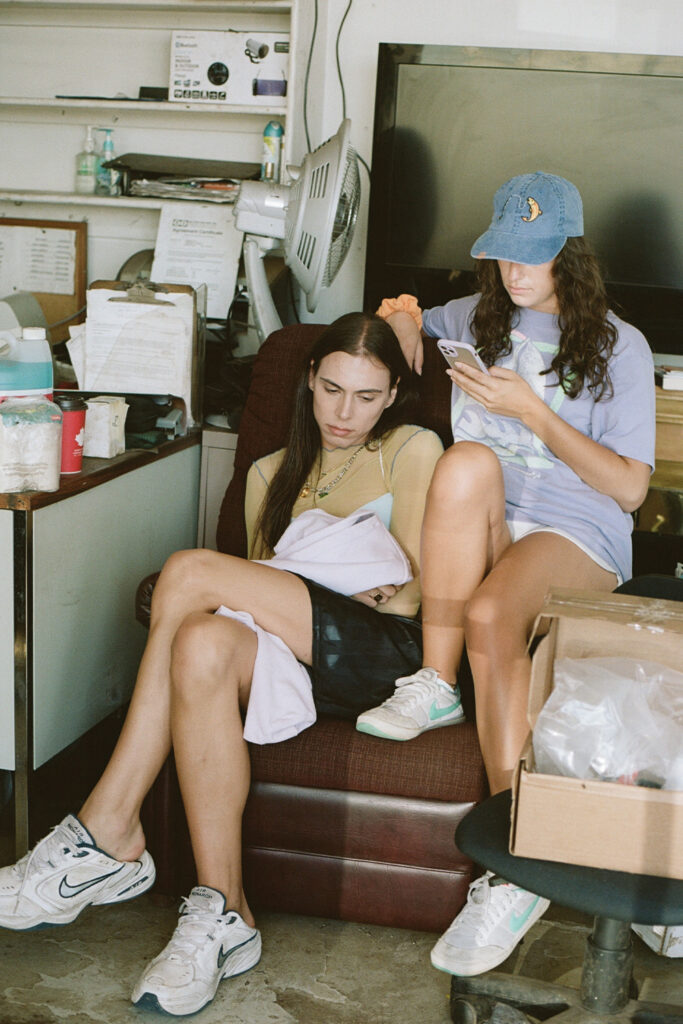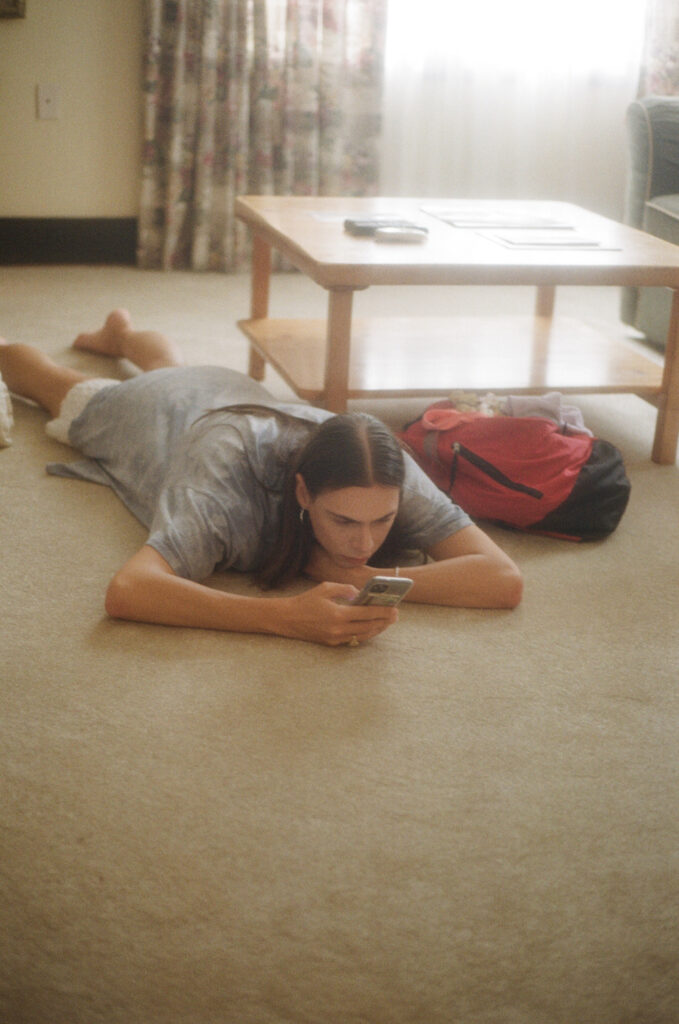Seven years after her sparkling debut in the film Firecrackers, costume designer Mara Zigler’s work has become known for striking the perfect balance between aesthetically pleasing, and candidly naturalistic all thanks to her dynamic and curious eye. In the glow of her fourth Canadian Screen Award nomination for achievement in costume design, this time for her work on Something You Said Last Night, filmmaker Luis De Filippis sits down with Zigler to chat about her process, the collaborative nature of filmmaking, and the small things that become big when designing for the screen.

Luis: So, are you ready to go back to the Fern?
Mara: “Yes, thinking about what I actually felt like in those moments that were crazy, that were good, that were bad, and that were weird, and fun, and magical and are now distant memories is odd.”
But the crazy thing is, you almost forget the bad, or romanticize it.
“Well the film is so beautiful that you just literally remember all the good stuff.”
So if a film doesn’t turn out the way you think it’s gonna turn out does that make you remember the bad more?
“I think so.”
But if you had to pick one, between a good process and a good –
“A good film. When your art looks a certain way and it becomes alive in the way that you’ve imagined it, there is no better feeling than that. But process matters. And I think now I’m trying to fight for process harder so that the two things can be married in wedded bliss. At the end of the day
the two things matter equally.”
Have you found over time that your reason for being a costume designer has changed?
“No one has ever asked me that. I honestly don’t think so. I have the same feeling I had when I worked on Firecrackers. You know, the same like, desire, drive, personal attachment to characters, and energy, and vibrations of people.”
I guess that’s what matters. Because then when you stop fighting, you become complacent.
“I think that’s the thing, I don’t want to be complacent. And it goes hand in hand with trying to reshape the way we view costumes in Canadian indies. That’s something I’m still fighting for and I feel like all the filmmakers I work with are still fighting for. But I don’t know why anyone would care about what I have to say. I’m like some fricking little schoonie-tee random costume designer. Nobody even cares about the work that we do except for what feels like a small handful of interesting artists, directors, and some producers that really fight for it. But outside of that, it feels like my fight is a small war waged with no one, with an invisible enemy.”
Well, not enough directors use costume design as a tool in their tool belt. But I think they also don’t use sound as like a tool in the tool belt. They don’t use production design. I think a lot of directors are really focused on camera and they’re very focused on script, sometimes actors.
“That’s what I have to say about your film is that every creative aspect that could be utilized was utilized, like everything was a tool. Everything was composed with the utmost care and intention, and then I got to feel like I was a part of that intention. We all worked towards one goal.”
In order for that to happen, everyone kind of has to put their ego aside and not think about, “How do I make my department shine?” but rather “ How do we make this film shine?” I think the greatest success of the film is that all the elements weave together seamlessly.
“That. When someone’s like, “Oh I saw your film, the costumes were like the best part,” I have failed.”
How do you approach relationships between departments? Because sometimes there can be such friction, but, I mean, I didn’t feel that from my perspective.
“Oh my god, zero friction. These people are truly incredible at what they do. Like, we prepped in the same space, we worked in the same room at the Fern that smelled like gasoline. And because of that, you know, Jordan (Giang, makeup artist) could always see the costumes we were using. I could literally walk across the hall and see what Matt (Bianchi, production design) was building; the colors and textures being used. And I took a lot away from the way that Norm (Li, cinematographer) shoots and his quiet attentiveness on set and the grace in which he moves with the camera. You start to move as one brain when you really have the same goals in mind.”

It all starts with the little things.
“Exactly, noticing the little things that everyone is bringing, and leaving the process open to accept what people have to offer. Like how Carmen turns all of her running shoes into slip-ons. It feels so true to the character of Ren, and has a piece of Carmen in there sealed with a little kiss. Then there’s that one scene where she’s lying on the ground and her little lacey bloomer butt is poking out. Matt turned to me and was like, “Those bloomers, what a special little doot.” And it’s true, it’s so random, and it’s nothing, and it’s just a choice of a million choices.”
And it’s just literally maybe half an inch of lace that you see.
“I know, the little lace.”
And that’s all you need.
“It tells you so much in such a quiet little way. It’s like this boyish oversized t-shirt with this little bit of feminine lace that pokes out the bottom is the amalgamation of all these different energies that Ren is able to embody all at once.”
I love geeking out about this stuff.
“It’s so fun. Joey, Ramona, Carmen, and Paige, they were down for all of these details. And came in for multiple fittings. And for people who don’t know, when you’re working on something that’s low budget, it is hard to bring actors in for multiple fittings. And nothing is good the first time. Somebody comes in once and you get 50% of the way there, you want to be at 100% by the time you start filming.”
Well, it’s like writing. The first draft is never good. Writing is rewriting. So costume design is fitting?
“Refitting. Fitting is refitting. That’s where we’re being like, okay, this old white cutoff from the bottom of a t-shirt is actually going to be turned into a shirt. And like, it shouldn’t even be a top, but it’s so charming and beautiful. When you dress these characters, and come up with their wardrobe you figure out things about them that you would never think about before.”
Which leads us to the contentious debate of like, labels: wardrobe versus costume designer.
“Well every person has a wardrobe, but not every person is a costume designer. The costume department has a really hard time garnering the same amount of money, resources, and respect as other departments for a myriad of historical reasons that are obvious and that we don’t need to go into. Language matters and I think in this case the label “costume designer” elevates the art to the level of all the other department heads and artists on the film. No shade if people want to call themselves wardrobe stylists, or wardrobe designers, but my credit is costume designer.”
As it should be, you are building costumes, and designing characters.
“Yes, Riley (Kizer, costume builder and buyer) built this little bathing suit for Carmen, but what it is, is you’re making this bathing suit for a specific person’s body, so that she can feel the most comfortable, both in real life and in the world of the film.”
And an actor’s comfort is crucial.
“It is. And it’s a huge undertaking, that really does fall on the costume department. I’m not setting up the gas generators to keep actors warm, but I am making sure that they’re there because I am the point person for an actor’s comfort. In those moments I have to lead with empathy; being a successful costume designer is caring for someone else’s body as you would care for your own.
Those are the parts of filmmaking that are invisible, and it isn’t always easy. But that’s why it’s worthwhile. Because no easy thing is worthwhile. I wouldn’t change any of it.”

